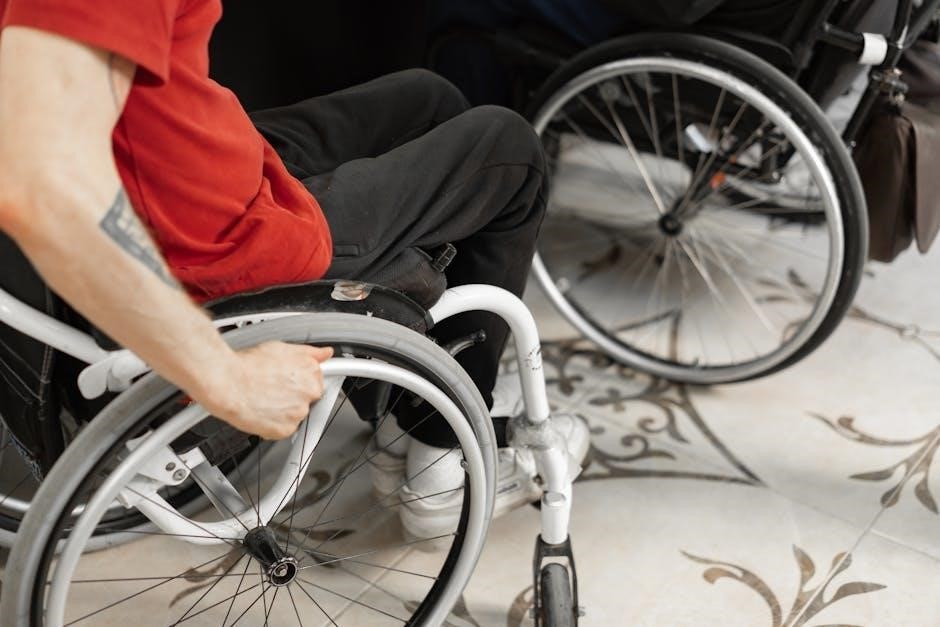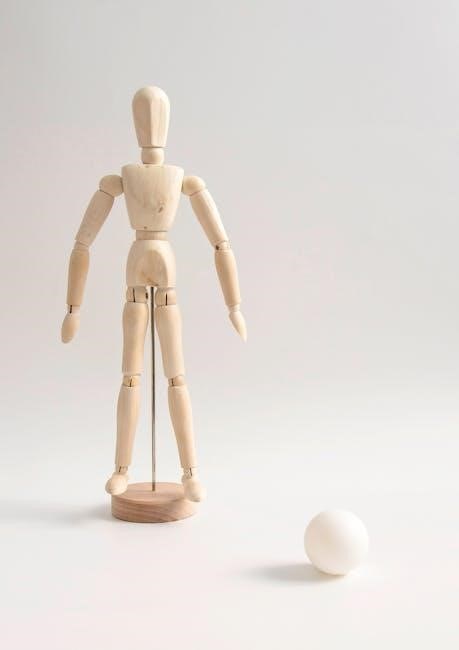Manual stand-up wheelchairs are innovative mobility devices designed to empower users with the ability to transition between sitting and standing effortlessly.
These chairs combine functionality‚ durability‚ and ergonomic design‚ offering enhanced mobility‚ independence‚ and health benefits for individuals with limited motor capabilities.
1.1 Definition and Purpose
A manual stand-up wheelchair is a mobility device designed to allow users to transition between sitting and standing positions effortlessly.
Its primary purpose is to empower individuals with limited mobility‚ enabling them to achieve greater independence‚ improve posture‚ and enhance overall well-being through the ability to stand upright.
These chairs combine manual operation with innovative mechanisms‚ offering a cost-effective solution for users seeking both mobility and the health benefits of standing.
1.2 Overview of Key Features
Manual stand-up wheelchairs feature adjustable frames‚ lightweight materials‚ and ergonomic designs for comfort and durability.
They incorporate hydraulic or mechanical systems to facilitate smooth transitions between sitting and standing‚ ensuring stability and safety.
Additional features include modular components‚ foldable designs‚ and customizable options to meet individual needs‚ enhancing both functionality and user experience.
History and Evolution
Manual stand-up wheelchairs originated from early mobility aids‚ evolving over decades to incorporate advanced engineering and ergonomic designs.
The first standing wheelchairs emerged in the 1970s‚ with LEVO pioneering the concept‚ leading to modern innovations in hydraulic systems and modular frameworks.
2.1 Early Development of Standing Wheelchairs
The early development of standing wheelchairs began in the 1970s‚ with LEVO AG inventing the first standing wheelchair‚ setting a precedent for future designs.
These initial models focused on basic functionality‚ using mechanical systems to assist users in transitioning between sitting and standing positions‚ laying the groundwork for modern innovations.
2.2 Modern Innovations in Design
Modern innovations in manual stand-up wheelchair design emphasize lightweight‚ durable materials like carbon fiber and aluminum‚ enhancing portability and strength.
Advanced hydraulic and mechanical systems enable smooth transitions between sitting and standing. Modular components and adjustable frames allow customization‚ reducing production costs.
Aesthetic options and ergonomic adjustments improve user comfort and satisfaction‚ making these wheelchairs more accessible and user-friendly.

Key Features and Technologies
Manual stand-up wheelchairs incorporate hydraulic systems‚ adjustable frames‚ and lightweight materials‚ ensuring smooth transitions and durability. Modular designs enhance customization‚ while ergonomic adjustments prioritize user comfort and accessibility.
3.1 Hydraulic and Mechanical Systems
Manual stand-up wheelchairs utilize advanced hydraulic and mechanical systems to facilitate smooth transitions between sitting and standing. These mechanisms provide sturdy support‚ enabling users to shift positions effortlessly while maintaining balance. The integration of ergonomic levers and compact actuators ensures efficient operation‚ making these systems both reliable and user-friendly for daily use.
3.2 Adjustable and Modular Components
Manual stand-up wheelchairs often feature adjustable and modular components‚ allowing for customizable fit and functionality. These include adjustable seat heights‚ footrests‚ and armrests‚ which can be tailored to individual preferences. Modular designs enable users to add or remove features‚ ensuring the chair adapts to their evolving needs‚ while maintaining lightweight and durable construction for optimal performance and comfort.
3.4 Safety Mechanisms and Stability
Manual stand-up wheelchairs incorporate essential safety mechanisms to ensure stability during transitions. Features like anti-tip bars‚ secure harnesses‚ and wide bases prevent accidents. These designs provide users with confidence and security while standing or sitting‚ minimizing risks associated with balance loss. Manufacturers prioritize rigorous testing to ensure these mechanisms are reliable and effective in real-world scenarios.

Benefits for Users
Manual stand-up wheelchairs offer enhanced mobility‚ independence‚ and improved health outcomes. Users benefit from better posture‚ reduced muscle atrophy‚ and increased confidence in daily activities and social interactions.
4.1 Health Advantages of Standing
Standing enables users to maintain proper posture‚ reducing the risk of muscle atrophy and pressure sores. It also improves blood circulation‚ strengthens muscles‚ and enhances overall physical health. Regular standing can boost mental well-being by allowing users to interact at eye level‚ fostering inclusivity and confidence in social settings.
4.2 Enhanced Mobility and Independence
Manual stand-up wheelchairs empower users to navigate various environments with greater ease‚ transitioning seamlessly between sitting and standing. This versatility allows for reaching high surfaces and interacting without assistance‚ fostering independence. Lightweight and modular designs further enhance portability‚ enabling users to maintain an active lifestyle and participate fully in daily activities without reliance on others.
4.3 Improved Social Interaction
Manual stand-up wheelchairs foster improved social interaction by allowing users to engage at eye level‚ reducing feelings of isolation. Standing upright enables natural communication and participation in group settings‚ enhancing confidence. This feature is particularly beneficial in social environments‚ promoting inclusivity and equality‚ and empowering users to connect more easily with others in various situations.
Design and Customization
Manual stand-up wheelchairs feature lightweight‚ durable materials and modular designs‚ allowing for customization to meet individual needs. Adjustable components and aesthetic options ensure a personalized fit and style.
5.1 Lightweight and Durable Materials
Manual stand-up wheelchairs are crafted with high-strength‚ lightweight materials such as aluminum and carbon fiber‚ ensuring durability while minimizing overall weight for enhanced portability and ease of use.
5.2 Aesthetic Options and Color Variability
Modern manual stand-up wheelchairs offer a range of stylish designs and customizable color options‚ allowing users to personalize their chairs to suit their preferences and lifestyles‚ enhancing both functionality and self-expression.
5.3 Ergonomic Adjustments for Comfort
Manual stand-up wheelchairs feature adjustable ergonomic designs‚ including customizable seat heights‚ footrests‚ and backrests‚ ensuring optimal comfort and postural support during both sitting and standing modes‚ tailored to individual user needs for enhanced usability and long-term health benefits.

Safety Considerations
Manual stand-up wheelchairs incorporate stability mechanisms and secure transition systems to minimize accidents‚ ensuring safe operation and emergency handling with proper user training.
6.1 User Training and Guidelines
Proper training is essential for safe operation of manual stand-up wheelchairs. Users must learn how to transition between sitting and standing smoothly and understand weight distribution.
Guidelines include practicing in a controlled environment‚ using safety harnesses‚ and following manufacturer instructions to prevent accidents and ensure stability during use.
6.2 Emergency Features and Fall Prevention
Manual stand-up wheelchairs often include emergency features like locking mechanisms and anti-tip wheels to enhance stability and prevent falls during transitions.
Some models incorporate safety harnesses and secure footrests‚ ensuring the user remains secure while standing or moving‚ thereby minimizing accident risks.
Design elements such as wide bases and low center-of-gravity configurations further contribute to overall stability‚ making these chairs safer for everyday use.

Comparison with Power-Assisted Models
Manual stand-up wheelchairs emphasize user strength and simplicity‚ while power-assisted models incorporate motors for easier propulsion‚ catering to different user needs and preferences.
Manual models are lighter and more portable‚ whereas power-assisted chairs offer greater convenience but may lack the same level of physical engagement.
7.1 Differences in Functionality
Manual stand-up wheelchairs rely on user strength for propulsion and standing‚ offering a lightweight‚ portable option. Power-assisted models incorporate motors for easier movement‚ reducing physical effort but adding weight and complexity.
7.2 User Preferences and Needs
Users seeking portability and independence often prefer manual stand-up wheelchairs for their lightweight design and ease of use. Those with limited strength may opt for power-assisted models‚ prioritizing ease of mobility over manual control‚ depending on their lifestyle and physical capabilities.

Real-World Applications
Manual stand-up wheelchairs are versatile tools used in various environments‚ from hospitals to outdoor settings‚ enhancing mobility for individuals with diverse needs and preferences.
8.1 Use in Various Environments
Manual stand-up wheelchairs are versatile‚ suitable for hospitals‚ homes‚ and outdoor settings‚ offering users mobility in diverse environments.
Their portability and durability make them ideal for both indoor and outdoor use‚ ensuring accessibility and independence in daily life and social interactions.
8.2 Testimonials and Success Stories
Users of manual stand-up wheelchairs often share inspiring stories of increased independence and confidence.
One user highlighted how the chair transformed their life‚ enabling them to stand and engage socially‚ while another praised its durability and ease of use in various settings‚ showcasing its impact on daily living and mobility.

Future Innovations
Emerging technologies promise advanced features like intelligent stair-climbing capabilities and modular designs‚ enhancing user experience and accessibility in manual stand-up wheelchairs.
9.1 Emerging Technologies
Emerging technologies are revolutionizing manual stand-up wheelchairs‚ with advancements like intelligent stair-climbing systems and modular‚ lightweight designs. Innovations such as hydraulic-assisted standing mechanisms and adaptive materials are enhancing functionality. Companies are also exploring AI integration for personalized adjustments‚ ensuring greater accessibility and independence for users. These cutting-edge solutions aim to redefine mobility‚ making stand-up wheelchairs more versatile and user-friendly.
9.2 Potential Market Impact
The integration of advanced technologies in manual stand-up wheelchairs is poised to significantly expand their market reach. Innovations like intelligent stair-climbing systems and modular designs are expected to increase demand‚ particularly among active users seeking greater independence. As awareness grows‚ these wheelchairs could become a mainstream solution‚ enhancing accessibility and improving quality of life for millions worldwide.
Manual stand-up wheelchairs empower users with independence‚ health benefits‚ and enhanced mobility‚ making them a transformative solution with growing popularity in the mobility aid market.
10.1 Summary of Advantages
Manual stand-up wheelchairs offer numerous benefits‚ including improved health through upright positioning‚ increased independence‚ and enhanced mobility.
Their ergonomic design promotes better posture and reduces the risk of complications like pressure sores.
Additionally‚ these wheelchairs allow users to interact socially on an equal level‚ boosting confidence and overall quality of life.
Their lightweight and durable construction ensures longevity and ease of use.
Overall‚ they provide a practical and empowering solution for individuals seeking greater autonomy and well-being.
10.2 Final Thoughts on Adoption
Manual stand-up wheelchairs represent a transformative advancement in mobility solutions‚ offering users independence‚ improved health‚ and enhanced quality of life.
Their adoption is highly recommended for individuals seeking to regain autonomy and confidence in their daily lives.
With customizable designs and innovative features‚ these wheelchairs cater to diverse needs‚ making them a valuable investment for long-term well-being.

